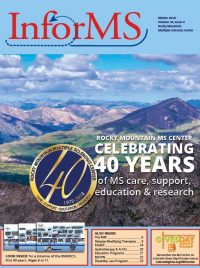By Pete Broderick | Since the mid-1990s, disease modifying therapies (DMTs) have been our first line interventions in the fight against MS. But what exactly do we mean by “DMT,” and how are they different from other drugs?
Put simply, DMTs are pharmaceutical treatments that alter the natural history of the disease itself. Before the first DMTs, doctors didn’t have a way to fight MS directly, so pharmaceutical interventions were limited to treating symptoms. That’s the distinction between DMTs and other drugs: when you’re taking a DMT, you’re fighting MS rather than just managing symptoms.
The time when patients need these more effective medications is highest when they are newly-diagnosed. That’s the most important time to try and suppress the inflammatory component of this condition. — Dr. John Corboy
Before DMTs, MS exacerbations were commonly fought with steroids, and various symptoms were treated individually. But there was simply nothing available to treat the MS itself.
The first class of drugs approved to directly fight MS came along in 1993. In the 25 years since then, the list of approved DMTs has grown to more than 15, with steady improvements in the mechanism of treatment and effectiveness along the way.
“All of the DMTs that we presently have available are anti-inflammatory, in one form or another,” says Dr. John Corboy, Co-Director of the RMMSC at CU. “They alter, adjust, suppress, or do something to the immune system that will be beneficial in knocking down the immune attack against the nervous system.”
Each new generation of DMTs since the mid-90s represented advancements in effectiveness, but with greater effect on the disease also sometimes comes with greater risk. As DMTs more aggressively fought MS, sometimes side effects and other risk factors were more severe as well.
We now have a great number of DMTs in the arsenal to fight MS, and doctors are able to tailor treatment plans for each patient. With large amounts of data from the usage of these drugs over the years, decisions can be made based on each patient’s situation.
“There are a lot of issues that go into decision-making,” says Corboy. “They have to do with patient issues, doctor issues, and insurance issues.”
There are a few strategies to prescribing the DMTs that are available today: the escalation, efficacy, and risk-appropriate approaches.
In the escalation approach, a doctor may start with what’s considered a “low-risk” medication. Generally, the low-risk medications are the first generation of DMTs. “These are relatively moderate medicines in terms of how well they work,” says Corboy. “But they have relatively low monitoring issues, relatively low risk in terms of long-term side effects.” If a patient does well and shows little or no signs of disease activity on a low-risk medication, their doctor may choose to keep right on going with that course of treatment. The risk with this strategy is while the drugs themselves are relatively safe, MS may continue to worsen over time.
In the high efficacy approach, treatment begins with the most effective medications as early as possible. “The risk of new inflammation diminishes with age,” says Corboy. “It’s highest when you’re younger — between 18 and 45, that’s the highest-risk time, when people are going to have new attacks, new relapses, new scan changes.”
Highly-effective treatments — generally, the newer DMTs — give us the best chance to stop MS progression in its tracks, and early treatment with the latest drugs have definitive benefits for patients.
“The time when patients need these more effective medications is highest when they are newly-diagnosed,” said Corboy. “That’s the most important time to try and suppress the inflammatory component of this condition.”
The problem with this strategy is that the highly-effective drugs may have higher risks associated with their use, and risks may be significant for some patients.
That leads us to the third strategy, which happens to be the preferred course of action at the Rocky Mountain MS Center, focused on maximizing the lifelong brain health of patients. The risk-appropriate approach involves building an individual treatment plan for each patient that takes into account more than just their MS, and balances the risk posed by the disease with the risk posed by the medicine used to fight it. This strategy allows doctors to tailor treatment for each patient.
“Risk-appropriate would be to match the risk of the disease — where that patient is, in that time in their life — with the efficacy and the risk of the medication,” says Corboy. Generally this strategy leans toward a high-efficacy approach, especially at the outset, but with the understanding that — for various reasons — some patients may be less tolerant of risks associated with some treatments, and therefore the higher efficacy DMTs might not be their best option. Patients and their doctors can work together to decide the best course of action.
This approach also implies that there could be a consideration to de-escalate treatment as risk of new disease activity diminishes with aging. This possibility is the subject of ongoing research at the RMMSC at CU.
Advancements in DMTs continue, and research into the next generation of treatments — and how best to use the current ones — is underway.
We’ve reached a point where current treatments can effectively halt the progress of MS in many patients, and significantly limit it in many more.

